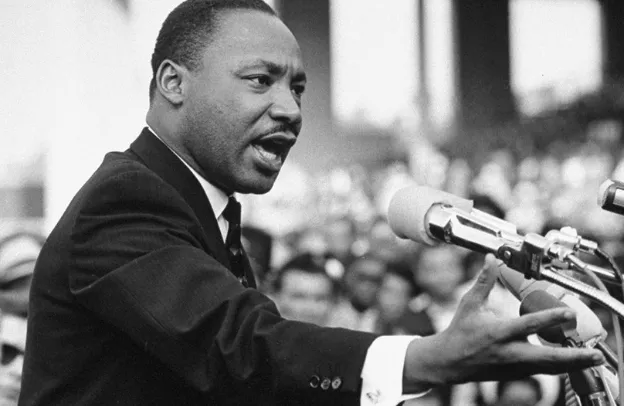“I Have A Dream” Speech By Martin Luther King, Jr. What Business Can Learn 60 Years Later

It was on August 28, 1963, during the March on Washington for Jobs and Freedom that Martin Luther King, Jr delivered the iconic speech, “I Have a Dream”. Ever since then, it has remained one of the most studied in the field of public speaking and the art of oratory.
Want to learn more about storytelling? Start by downloading the first chapter of The Storytelling Mastery for Businesses.
Now, beyond its historical significance in the civil rights movement, how can this speech serve as a powerful pillar for business owners who are seeking to connect with their audience through the art of storytelling?
In this presentation, I will share with you what made this speech so iconic and how you can replicate a similar technique in your business storytelling.
Employing The Magic of Language
There is no doubt that you can identify several techniques from this powerful 1963 speech by Martin Luther King, Jr but the appropriate use of language is where I would like us to start this presentation. By masterfully employing rich language, King painted a vivid picture of his dream for a more just and inclusive society.
His use of phrases like “I have a dream that my four little children will one day live in a nation where they will not be judged by the color of their skin but by the content of their character” resonated deeply with the audience.
Now, how can this relate to you as a business owner? When crafting your business narrative, make sure to use language that truly connects with your audience on an emotional level. Identify the values that matter to your brand and express them through compelling and relatable stories.
Whether it’s about your company’s journey, commitment to quality, or dedication to social responsibility, learn to articulate it with rich language that leaves a lasting impression on your audience. You can never underestimate the effectiveness of your business storytelling.
The power of Repetition in literary works
This is another great instrument King perfectly used to deliver his masterpiece “I Have a Dream speech”. Like King, the strategic use of repetition can be a brilliant secret to developing great oratory skills. The recurrent cadence of such phrases as “I have a dream” not only served as a poetic refrain but also engraved the core message into the hearts and minds of his listeners.
Repetition can be a powerful tool in your business communication as well. So, make sure you identify the key messages or values you want your audience to remember and carefully incorporate them across your marketing materials, presentations, and communications.
I am not saying, you can become Martin Luther King, Jr. but by leveraging the power of repetition, you can greatly enhance your brand recall and ensure that your core messages become ingrained in the minds of your customers.
That is what separates a carefully crafted message from the armature, or those which are hastily created, like the “Me Too” type of content, flooding the internet today. So, you want to differentiate yourself by leveraging the power of repetition in your business storytelling.
Martin Luther King and his Rhetoric Power
One of the techniques King greatly leveraged in his speech, is the power of rhetorical devices. He used it to an extraordinary degree, weaving eloquence that transcends the moment and etching its significance in history.
King’s skillful use of anaphora, exemplified by the iconic refrain “I have a dream,” created a recurring and resonant cadence, thereby reinforcing the urgency of his vision.
In case you are new to the term, anaphora is a rhetorical device consisting of repeating a sequence of words at the beginnings of succeeding clauses, to create emphasis. In contrast, an epistrophe which is another literary term you might hear me refer to in this presentation is the repetition of words at the ends of clauses.
If you reread or listen to the speech, you will see how, through metaphorical language, King painted vivid images, such as justice rolling down like waters. This helps to amplify the emotional impact of his message.
This was further reinforced by his allusions to historical events, particularly about Lincoln’s Gettysburg Address. This surely added depth and connected the civil rights struggle to the broader American narrative.
What I want you to understand here is that none of this is by random choice of words, and neither should yours be in business storytelling. Instead, King’s deliberate deployment of parallelism, antithesis, and epistrophe heightened the rhetorical impact, thereby emphasizing key points, and creating contrasts to take the audience along. And it worked perfectly well by gradually building towards a powerful crescendo at the end.
In this way, King’s use of rhetorical devices transformed his speech into a timeless masterpiece, illustrating the powerful strategic language in driving a message home. Now, let’s see how business owners can use the same power of rhetoric in their communications.
Interludes
How businesses can do the same
Sure, businesses can emulate this impactful use of rhetorical devices to elevate their communication strategies. As a business owner, you can start by incorporating anaphora to create memorable refrains or slogans that encapsulate your brand’s key messages.
Talking of anaphora, make sure the repeated word or words appear at the beginning of two or more phrases. Also, be sure that the repeated words or words feel deliberate and have a sense of meaning within the context of their usage.
Don’t forget that as a business storyteller, crafting metaphorical narratives should vividly convey your company’s values, goals, and impact. This will help make your story more relatable and emotionally compelling. When appropriate, you can enrich this further by integrating historical or cultural allusions to buttress your message. You can also ground your brand narrative in a broader context that resonates with your audience.
As King beautifully did in his speech, you can equally embrace parallelism and antithesis to structure your messages with balance and contrast. This will help you to emphasize the important points and foster better engagement with your audience.
Remember that strategically incorporating these rhetorical devices into your communication can greatly enhance your business storytelling. But there is even more to learn from King’s speech if you truly want to captivate your audiences and create a memorable connection.
I am talking about his Fearless Expression. Sure, there are times when you need to be Fearless in your Expression. So, let’s consider that.
Dr King’s Fearless Expression during his speech
King’s speech was fearless, unapologetically confronting the issues of racial injustice and inequality head-on. This includes his caution to his audience to be mindful of their action even when they fight against oppressive social and political structures.
That is one of the key factors that made his 1963 speech so iconic even today, 60 years later. Consider the following lines, for example:
“But there is something that I must say to my people who stand on the warm threshold which leads into the palace of justice. In the process of gaining our rightful place, we must not be guilty of wrongful deeds. Let us not seek to satisfy our thirst for freedom by drinking from the cup of bitterness and hatred.”
By cautioning against responding to injustice with bitterness and hatred, King demonstrated courage that went beyond calling out external oppressors. This internal call to accountability showcased his fearless commitment to both confronting societal issues and promoting a constructive and morally upright path toward change.
Now, business owners can learn from this fearlessness, understanding that authenticity and honesty resonate deeply with audiences rather than superficialities and fluffs.
To connect with your audience authentically, make sure you acknowledge challenges, and express a commitment to overcoming them. Whether it’s addressing shortcomings, sharing lessons learned, or championing a cause, fearlessness in communication builds trust.
So, being transparent about your brand’s journey, challenges, and growth, demonstrates a genuine commitment to improvement.
What I am telling you is that no matter what, always remember to embrace your values, address challenges directly, and showcase your commitment to positive change. In doing so, you will build trust and loyalty among your customers.
The last point I would like to share with you about this great speech is Connecting Dreams to Reality and you don’t want to underestimate that in your business storytelling. Especially if you want to share a bigger dream and you need people to believe in your vision.
Connecting Dreams to Reality
King’s dream was not a mere abstraction; it was a call to action. How did he do that in his speech? You might want to ask. Well, King connected dreams to reality by aligning his vision with the foundational principles of the American dream — the idea that all are created equal.
He didn’t stop at aspiration; he outlined actionable steps, urging immediate and collective efforts to fulfill the promises of American democracy. King’s approach of grounding the dream in core values while providing a clear roadmap for tangible change serves as a powerful lesson for businesses today.
In your business, you can do this by aligning your vision with core values, clearly articulating steps toward goals, and emphasizing practical actions. This will help you turn aspirations into reality for credibility and audience inspiration.
If your business has a mission or purpose, translate it into actionable steps that align with your values. Whether it’s sustainability initiatives, community involvement, or customer-focused improvements, always make sure you demonstrate how your brand’s dreams are actively shaping a better reality.
This not only inspires your audience but also positions your business as one that is making a positive impact in the world.
What is the conclusion?
In conclusion, there is a lot of value to learn from King’s speech in 1963, where he called for civil and economic rights and an end to racism in the United States. But the “I Have a Dream” speech transcends its historical context to offer timeless lessons for businesses who are aiming to connect with their audience and drive positive change.
Business leaders, today, can garner valuable techniques from King’s example, and incorporate them into their communication strategies for more effective narratives. Learn from the Master and choose to inspire and foster authentic connections.
Did you find this video helpful? Make sure to share it with others who might need it. And remember to subscribe to this channel for more videos like this. Talk to you in the next video.
Want to learn more about storytelling? Start by downloading the first chapter of The Storytelling Mastery for Businesses.






